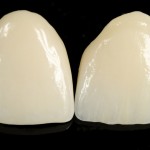
The crowning of teeth is a very common clinical procedure although it typically results in the irreversible loss of more than 60% of the tooth structure. Studies have suggested that the need for endodontic treatment following crown placement can range from 3- 19%. Surveys also suggest that a majority of practitioner chose to gain access to the pulp through existing crowns and keep as a permanent restoration, rather than remove it.
The aim of this review was to identify from in-vitro studies the effect of endodontic access on the fracture resistance and damage around the access cavity of all-ceramic crowns.
Methods
Searches were conducted in the Medline/PubMed Web of Science, Scopus, Embase, and OpenGrey databases with no restrictions. In-vitro studies assessing the effect of on endodontic access on all-ceramic crowns were considered. Two reviewers selected studies, abstracted data and assessed study quality.
Results
- 8 in-vitro studies were included.
- 3 were considered to be at low risk of bias, 2 medium risk and 3 high risk.
- Sample sizes of studies ranged from 6 – 60
- 4 studies used extracted teeth for the die substrate,3 epoxy or resin composite and 1 a metal die.
- Access cavity dimensions varies across the studies.
- Failure load varied with repair protocol, type of ceramic material, bur grit size, luting agent and method of crown fabrication.
- Meta-analysis was not conducted due to high levels of heterogeneity.
Conclusions
The authors concluded
Based on the currently available scientific evidence, a ‘best practice’ protocol with regard to improving the fracture resistance of endodontically accessed and repaired all-ceramic crowns cannot be conclusively identified. However, some key factors which potentially impact on the fracture resistance of endodontically accessed and repaired all-ceramic crowns have been isolated. Cautious clinical interpretation of these factors is concluded for the maintenance of the crown as a permanent restoration.
Comments
This review sought to assess the impact of endodontic access on the fracture resistance of all-ceramic crowns by looking at in-vitro studies. While a broad search was conducted only a small number of studies were identified and the variation between them did not allow meta-analysis. The variation in crown materials, processing techniques, luting agents, die substrate and the lack of detail regarding access cavity dimensions, and repair materials limited the available comparisons. Consequently this review mainly serves to highlight issues with the quality of the reporting of the primary studies and suggest areas that may be of potential relevance clinically. For while in-vitro studies can provide some insight as to what might happen in similar clinical circumstances they inevitable fail to replicate the more diverse range of functional stresses and strains encountered in an individuals mouth.
Links
Primary paper
Gorman CM, Ray NJ, Burke FM. The effect of endodontic access on all-ceramic crowns: A systematic review of in vitro studies. J Dent. 2016 Oct;53:22-9.
doi: 10.1016/j.jdent.2016.08.005. Review. PubMed PMID: 27542693.
Other references

Ceramic crowns: effect of endodontic access on fracture resistance https://t.co/oHmBCES1W8
[…] post Ceramic crowns: effect of endodontic access on fracture resistance appeared first on National Elf […]
Ceramic crowns: effect of endodontic access on fracture resistance https://t.co/MU9nYLS7Dz
Endodontically accessed and repaired all-ceramic crowns -few keys to best practice https://t.co/MU9nYLAweZ
Effect of endodontic access on fracture resistance of all-ceramic crowns https://t.co/MU9nYLS7Dz
Limited evidence to best practice for endodontically accessed and repaired all-ceramic crowns https://t.co/MU9nYLS7Dz
Don’t miss- Ceramic crowns: effect of endodontic access on fracture resistance https://t.co/MU9nYLS7Dz